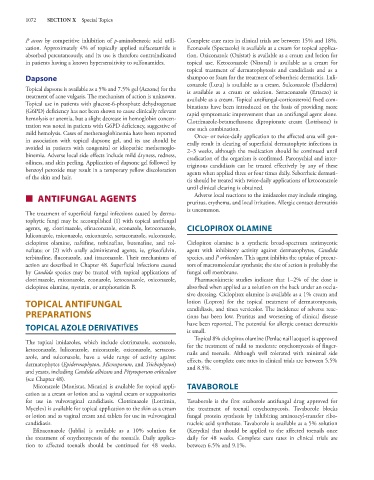Page 1086 - Basic _ Clinical Pharmacology ( PDFDrive )
P. 1086
1072 SECTION X Special Topics
P acnes by competitive inhibition of p-aminobenzoic acid utili- Complete cure rates in clinical trials are between 15% and 18%.
zation. Approximately 4% of topically applied sulfacetamide is Econazole (Spectazole) is available as a cream for topical applica-
absorbed percutaneously, and its use is therefore contraindicated tion. Oxiconazole (Oxistat) is available as a cream and lotion for
in patients having a known hypersensitivity to sulfonamides. topical use. Ketoconazole (Nizoral) is available as a cream for
topical treatment of dermatophytosis and candidiasis and as a
Dapsone shampoo or foam for the treatment of seborrheic dermatitis. Luli-
conazole (Luzu) is available as a cream. Sulconazole (Exelderm)
Topical dapsone is available as a 5% and 7.5% gel (Aczone) for the is available as a cream or solution. Sertaconazole (Ertaczo) is
treatment of acne vulgaris. The mechanism of action is unknown. available as a cream. Topical antifungal-corticosteroid fixed com-
Topical use in patients with glucose-6-phosphate dehydrogenase binations have been introduced on the basis of providing more
(G6PD) deficiency has not been shown to cause clinically relevant rapid symptomatic improvement than an antifungal agent alone.
hemolysis or anemia, but a slight decrease in hemoglobin concen- Clotrimazole-betamethasone dipropionate cream (Lotrisone) is
tration was noted in patients with G6PD deficiency, suggestive of one such combination.
mild hemolysis. Cases of methemoglobinemia have been reported Once- or twice-daily application to the affected area will gen-
in association with topical dapsone gel, and its use should be erally result in clearing of superficial dermatophyte infections in
avoided in patients with congenital or idiopathic methemoglo- 2–3 weeks, although the medication should be continued until
binemia. Adverse local side effects include mild dryness, redness, eradication of the organism is confirmed. Paronychial and inter-
oiliness, and skin peeling. Application of dapsone gel followed by triginous candidiasis can be treated effectively by any of these
benzoyl peroxide may result in a temporary yellow discoloration agents when applied three or four times daily. Seborrheic dermati-
of the skin and hair.
tis should be treated with twice-daily applications of ketoconazole
until clinical clearing is obtained.
Adverse local reactions to the imidazoles may include stinging,
■ ANTIFUNGAL AGENTS pruritus, erythema, and local irritation. Allergic contact dermatitis
is uncommon.
The treatment of superficial fungal infections caused by derma-
tophytic fungi may be accomplished (1) with topical antifungal
agents, eg, clotrimazole, efinaconazole, econazole, ketoconazole, CICLOPIROX OLAMINE
luliconazole, miconazole, oxiconazole, sertaconazole, sulconazole,
ciclopirox olamine, naftifine, terbinafine, butenafine, and tol- Ciclopirox olamine is a synthetic broad-spectrum antimycotic
naftate; or (2) with orally administered agents, ie, griseofulvin, agent with inhibitory activity against dermatophytes, Candida
terbinafine, fluconazole, and itraconazole. Their mechanisms of species, and P orbiculare. This agent inhibits the uptake of precur-
action are described in Chapter 48. Superficial infections caused sors of macromolecular synthesis; the site of action is probably the
by Candida species may be treated with topical applications of fungal cell membrane.
clotrimazole, miconazole, econazole, ketoconazole, oxiconazole, Pharmacokinetic studies indicate that 1–2% of the dose is
ciclopirox olamine, nystatin, or amphotericin B. absorbed when applied as a solution on the back under an occlu-
sive dressing. Ciclopirox olamine is available as a 1% cream and
TOPICAL ANTIFUNGAL lotion (Loprox) for the topical treatment of dermatomycosis,
candidiasis, and tinea versicolor. The incidence of adverse reac-
PREPARATIONS tions has been low. Pruritus and worsening of clinical disease
TOPICAL AZOLE DERIVATIVES have been reported. The potential for allergic contact dermatitis
is small.
Topical 8% ciclopirox olamine (Penlac nail lacquer) is approved
The topical imidazoles, which include clotrimazole, econazole, for the treatment of mild to moderate onychomycosis of finger-
ketoconazole, luliconazole, miconazole, oxiconazole, sertacon- nails and toenails. Although well tolerated with minimal side
azole, and sulconazole, have a wide range of activity against effects, the complete cure rates in clinical trials are between 5.5%
dermatophytes (Epidermophyton, Microsporum, and Trichophyton) and 8.5%.
and yeasts, including Candida albicans and Pityrosporum orbiculare
(see Chapter 48).
Miconazole (Monistat, Micatin) is available for topical appli- TAVABOROLE
cation as a cream or lotion and as vaginal cream or suppositories
for use in vulvovaginal candidiasis. Clotrimazole (Lotrimin, Tavaborole is the first oxaborole antifungal drug approved for
Mycelex) is available for topical application to the skin as a cream the treatment of toenail onychomycosis. Tavaborole blocks
or lotion and as vaginal cream and tablets for use in vulvovaginal fungal protein synthesis by inhibiting aminoacyl-transfer ribo-
candidiasis. nucleic acid synthetase. Tavaborole is available as a 5% solution
Efinaconazole (Jublia) is available as a 10% solution for (Kerydin) that should be applied to the affected toenails once
the treatment of onychomycosis of the toenails. Daily applica- daily for 48 weeks. Complete cure rates in clinical trials are
tion to affected toenails should be continued for 48 weeks. between 6.5% and 9.1%.

